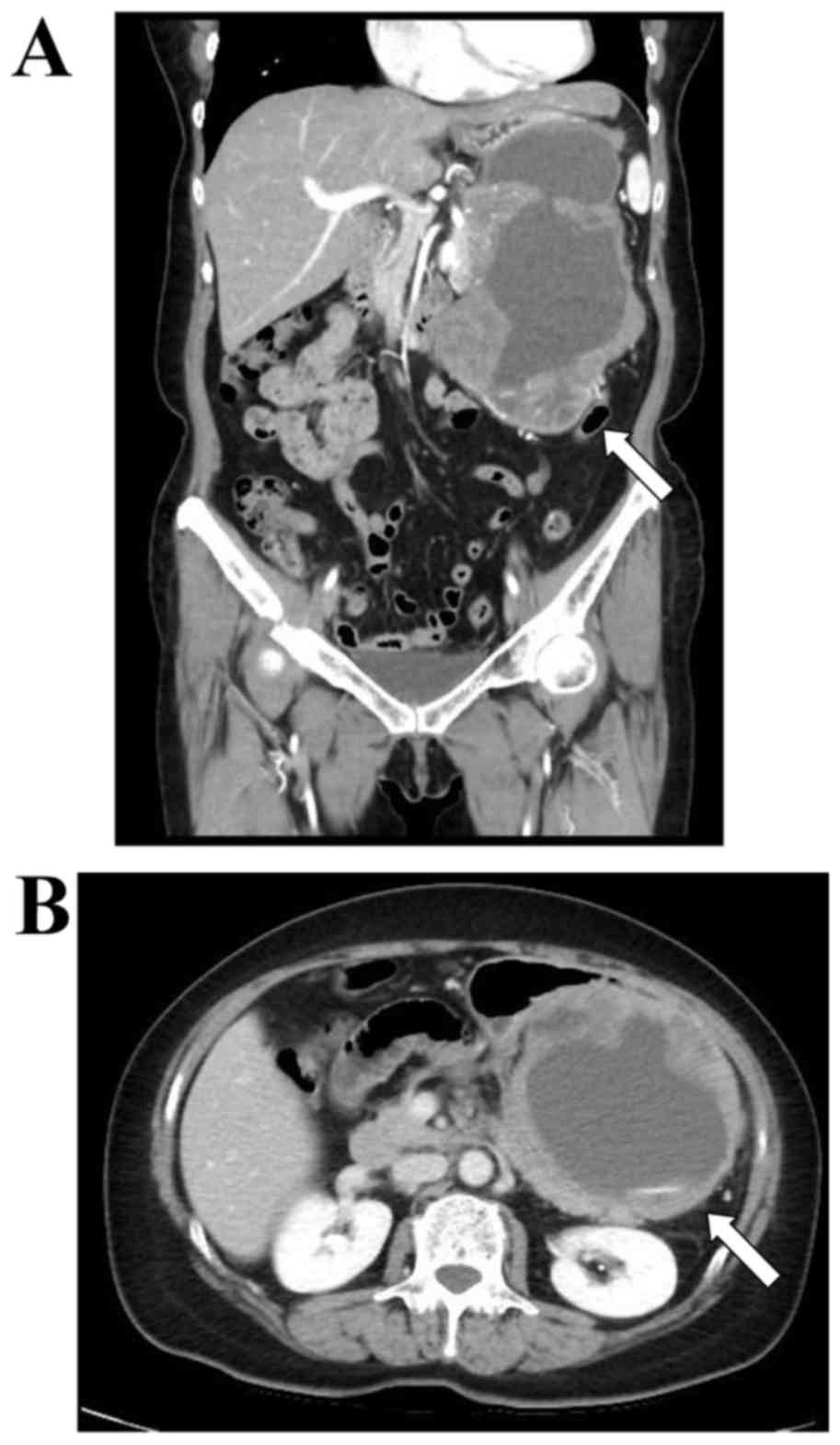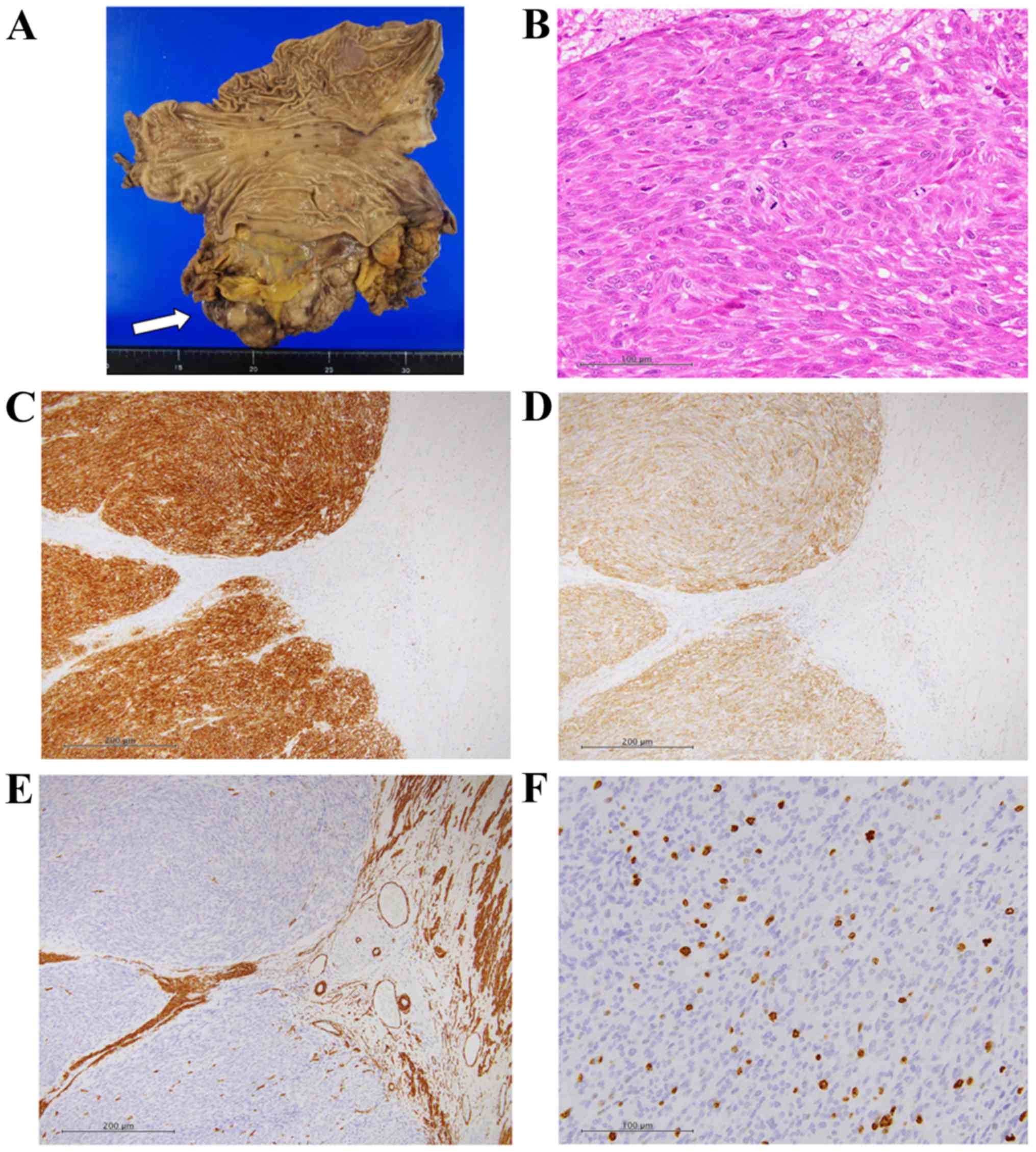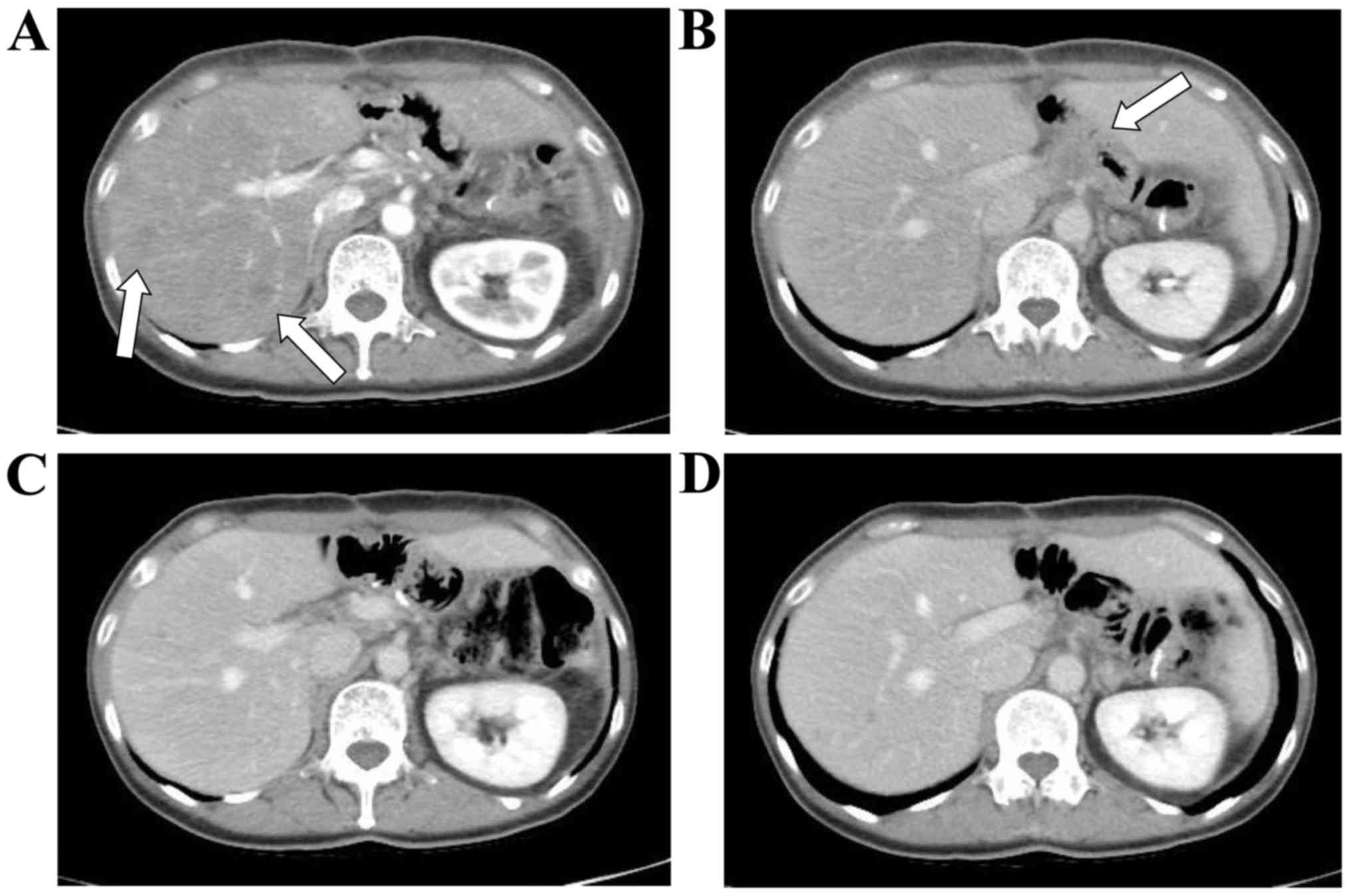Complete response to second-line chemotherapy with sunitinib of a gastrointestinal stromal tumor: A case report
- Authors:
- Published online on: May 23, 2017 https://doi.org/10.3892/mco.2017.1268
- Pages: 93-97
Abstract
Introduction
Gastrointestinal stromal tumors (GISTs) are a type of sarcoma, and the most common mesenchymal tumor of the gastrointestinal tract. They arise from the intestinal cells of Cajal, typically present in older individuals, and are most commonly identified in the stomach, followed by the small intestine (1). In Japan, GISTs arise from the stomach most frequently in 1–2 per 100,000 people (2). Most GISTs express the protein product of the KIT proto-oncogene, a transmembrane receptor tyrosine kinase, the activity of which would normally be regulated by the binding of its ligand. KIT is positive in ~95% of GISTs, and so, if a tumor is positive for KIT on performing immunohistochemistry and the cells appear as GIST morphologically on hematoxylin-eosin staining, it may be diagnosed as GIST (3). CD34 is positive in 70–80% of the cases of GIST, and certain CD34-positive tumors may be diagnosed as GIST, unless KIT is negative (4).
More than 40% of GISTs are clinically malignant and thought to be metastatic (1,5–7), so there are a large number of GIST cases for which systemic chemotherapy is indicated. Imatinib mesylate is an oral multitargeted receptor tyrosine kinase inhibitor that is effective as adjuvant chemotherapy for primary high-risk cases (8,9), and as palliative chemotherapy for unresectable or metastatic cases (10,11).
For unresectable or metastatic cases of imatinib-resistant GIST, second-line chemotherapy is recommended. Sunitinib mesylate is an oral multitargeted receptor tyrosine kinase inhibitor whose effects are associated with blockade of receptor tyrosine kinase signaling by KIT, platelet-derived growth factor receptors (PDGFRs), three isoforms of the vascular endothelial growth factor receptors (VEGFR-1, VEGFR-2 and VEGFR-3), and Fms-like tyrosine kinase-3 receptor (FLT3). In cases of GIST, sunitinib exhibited significant longer median progression-free survival (mPFS) and higher response rates (RRs) compared with a placebo (12). Continuous daily dosing of sunitinib was also reported to be effective for disease control (13). However, to the best of our knowledge, there have been no cases showing a complete response (CR) in the prospective clinical trials examining the effects of sunitinib for GIST, and in CR case reports worldwide.
Therefore, a very rare case of a patient with metastatic GIST who achieved CR with sunitinib as second-line chemotherapy is reported in the present study. This is a very rare case report of CR with sunitinib as second-line chemotherapy for GIST worldwide.
Case presentation
A 54-year-old woman presented with persistent upper abdominal pain and anorexia, and she visited a local doctor in March 2015. The patient had a history of operations for a myoma of the uterus, and she had no history of smoking or drinking. Her family history included no cancers. Abdominal ultrasound revealed a subcutaneous mass of the upper abdomen, and an upper gastrointestinal endoscopy revealed a submucosal tumor of the posterior wall of the stomach. Since GIST of the stomach was suspected, the patient was referred to the Department of Surgery of Miyazaki Prefectural Miyazaki Hospital (Miyazaki, Japan) in April 2015. An abdominal ultrasound revealed free space in the tumor. Since the patient's systolic blood pressure was 80 mmHg and her hemoglobin level was 8.0 g/dl, she was diagnosed with hypovolemic shock due to tumor hemorrhage. Since no distant metastases were observed on computed tomography (CT) (Fig. 1), the patient underwent total gastorectomy and distal pancreatectomy with splenectomy for advanced invasive tumor. Histological examination of the resected specimen demonstrated rupture and hemorrhage of the tumor, the maximum diameter of which was >15 cm (Fig. 2A). The tumor consisted of spindle or polygonal-shaped cells having larger nuclei. Immunohistochemically, the cells were positive for KIT and CD34, and partly positive for smooth muscle actin and p53 (Fig. 2B-E). They were negative for S100 and desmin, and the MIB-1 positive rate was 10.07% (288/2859 cells) (Fig. 2F). The tumor was completely resected. Since the patient was diagnosed as high-risk GIST using the modified-Fletcher classification (rupture, size >10 cm, mitoses >10/50 per high-power field), adjuvant chemotherapy with imatinib for 3 years was indicated.
The patient was referred to our department in May 2015. Her general condition was good, and organ functions were well preserved. Therefore, systemic chemotherapy was started with 400 mg/body/day of imatinib. The dose of imatinib was reduced to 300 mg/body/day due to Common Terminology Criteria for Adverse Events Version 4.0 (CTCAEv4.0) grade 2 diarrhea in June 2015. However, multiple metastases in the liver and a metastatic lymph node near the celiac artery were detected on performing CT in November 2015 (Fig. 3A and B).
The patient's Eastern Cooperative Oncology Group performance status was 0, and vital signs were within normal ranges. Blood testing revealed a decreased red blood cell count of 329×104/µl and a decreased hemoglobin level of 10.8 g/dl, although the patient's general condition was good, and organ functions were preserved. Second-line chemotherapy with sunitinib (50 mg/body/day, days 1–28, every 6 weeks) was started. From the second cycle of chemotherapy, the dose of sunitinib was reduced to 37.5 mg/body/day due to CTCAEv4.0 grade 1 fatigue. CTCAEv4.0 grade 1 diarrhea and grade 1 proteinuria were also observed, but no other severe adverse events occurred. After four cycles of chemotherapy, the liver and lymph node metastases disappeared, and a CR, as defined by Response Evaluation Criteria In Solid Tumors version 1.1, was achieved in February 2016 (Fig. 3C and D). The patient then strongly demanded that chemotherapy be stopped, although our recommendation was that it be continued. CT at the end of August 2016 again revealed a CR. However, tumor recurrence was detected in November 2016, indicating that CR had been maintained for 6 months. The patient received sunitinib again, and partial response was achieved after 3 months.
Discussion
This patient could be diagnosed with GIST histologically because of positivity for CD34 and KIT (3). Risk classification is used for GIST cases with no metastases. Historically, the Fletcher classification, which consisted of tumor size and mitoses, was used first (14). It was also reported that the MIB-1 labeling index and the existence of tumor necrosis were useful as indicators of tumor proliferation (15–17). The prognosis of GIST has appeared to be different in different tumor sites, so the Miettinen classification has been used as a standard for predicting tumor recurrence (18). Furthermore, the modified Fletcher classification, consisting of tumor size, mitoses, tumor sites, and tumor rupture, was reported to be more useful for the selection of high-risk recurrent cases (19). This case was diagnosed as high-risk GIST with the modified Fletcher classification. Though the modified Fletcher classification is a discontinuous indicator for risk assessment, the contour maps are considered to be continuous and useful for the diagnosis of tumor recurrence (19). In the present case study, the probability of tumor recurrence was within 80–90% by the contour maps. Therefore, adjuvant chemotherapy with imatinib was indicated for the present study.
For GIST patients whose tumors are totally resected, imatinib is effective as adjuvant chemotherapy for primary high-risk cases in order to improve recurrence-free survival (8,9). For progressive disease cases treated with 400 mg/body of imatinib therapy, dose escalation of imatinib to 800 mg/body was reported to be effective in the EORTC62005 and the S0033 trials (20,21). Increasing the dosage of imatinib could have been effective for this patient, but Japanese patients cannot receive 800 mg/body of imatinib as, due to the medical insurance system of Japan, the maximal dose of imatinib for GIST is 400 mg/body.
Sunitinib is recommended for imatinib-resistant GISTs in unresectable or metastatic cases; it is associated with a significantly longer mPFS and higher RR (12). Clinical evaluation of continuous daily dosing of sunitinib in patients with advanced GISTs following imatinib failure has been analyzed (13); the disease control rate of sunitinib was 53%, RR was 13%, mPFS was 34 weeks, and median overall survival (OS) was 107 weeks. Sahu et al (22) reported no CR cases among 15 Indian patients prospectively administered sunitinib as second-line chemotherapy. Thus, in the prospective clinical trials examining the effects of sunitinib, no cases demonstrated CR.
Retrospective reports of CR cases with second-line chemotherapy involving sunitinib are also few in number. Dudeck et al (23) retrospectively identifed no CR cases among 51 German patients. To the best of our knowledge, there have been three cases showing CR with sunitinib as second-line chemotherapy for GISTs reported retrospectively: 2/199 (1.0%) patients showed CR in a Taiwanese study (24), and 1/48 patients (2.1%) showed CR in a Chinese study (25). No individual case reports have been published worldwide, so that the present study is a very rare case report showing CR. Furthermore, CR could have been maintained longer if the patient had not demanded that chemotherapy be stopped.
This case report has several limitations. For example, fluorodeoxyglucose-positron emission tomography (FDG-PET) was not performed. This technique is able to detect metastatic lesions that are negative on other modalities, and the patient in this case study could have had other metastases prior to starting sunitinib treatment. However, there are also FDG-PET-negative GIST cases, so that FDG-PET is not considered a substitute for CT (26). Furthermore, detection of a KIT mutation was not performed. Imatinib has a less marked effect for GIST cases with PDGFRA exon 18 D842V mutation (20), and decreases from the baseline in plasma levels of soluble KIT following 20 and 24 weeks of dosing were correlated with a longer OS (13). Finally, the four CR cases were all Asian patients, suggesting that Asian patients may have certain factors that are associated with the effects of sunitinib.
In conclusion, a very rare case of GIST that achieved CR with second-line sunitinib was described. This information should be of importance not only for the treatment of GISTs, but also clinical research.
Acknowledgements
The authors would like to thank the medical staff for their contribution to patient diagnosis and treatment.
References
|
Miettinen M and Lasota J: Gastrointestinal stromal tumors-definition, clinical, histological, immunohistochemical, and molecular genetic features and differential diagnosis. Virchows Arch. 438:1–12. 2001. View Article : Google Scholar : PubMed/NCBI | |
|
Japanese Clinical Practice Guidelines for Gastrointestinal Stromal Tumors (GIST). 3rd. Japan Society of Clinical Oncology; pp. 1–16. 2004 | |
|
Hirota S, Isozaki K, Moriyama Y, Hashimoto K, Nishida T, Ishiguro S, Kawano K, Hanada M, Kurata A, Takeda M, et al: Gain-of-function mutations of c-kit in human gastrointestinal stromal tumors. Science. 279:577–580. 1998. View Article : Google Scholar : PubMed/NCBI | |
|
Miettinen M, Sobin LH and Sarlomo-Rikala M: Immunohistochemical spectrum of GISTs at different sites and their differential diagnosis with a reference to CD117 (KIT). Mod Pathol. 13:1134–1142. 2000. View Article : Google Scholar : PubMed/NCBI | |
|
Pierie JP, Choudry U, Muzikansky A, Yeap BY, Souba WW and Ott MJ: The effect of surgery and grade on outcome of gastrointestinal stromal tumors. Arch Surg. 136:383–389. 2001. View Article : Google Scholar : PubMed/NCBI | |
|
DeMatteo RP, Lewis JJ, Leung D, Mudan SS, Woodruff JM and Brennan MF: Two hundred gastrointestinal stromal tumors: Recurrence patterns and prognostic factors for survival. Ann Surg. 231:51–58. 2000. View Article : Google Scholar : PubMed/NCBI | |
|
Plaat BE, Hollema H, Molenaar WM, Broers GH Torn, Pijpe J, Mastik MF, Hoekstra HJ, van den Berg E, Scheper RJ and van der Graaf WT: Soft tissue leiomyosarcomas and malignant gastrointestinal stromal tumors: Differences in clinical outcome and expression of multidrug resistance proteins. J Clin Oncol. 18:3211–3220. 2000. View Article : Google Scholar : PubMed/NCBI | |
|
Joensuu H, Eriksson M, Hall K Sundby, Hartmann JT, Pink D, Schütte J, Ramadori G, Hohenberger P, Duyster J, Al-Batran SE, et al: One vs three years of adjuvant imatinib for operable gastrointestinal stromal tumor: A randomized trial. JAMA. 307:1265–1272. 2012. View Article : Google Scholar : PubMed/NCBI | |
|
Kanda T, Nishida T, Wada N, Kobayashi O, Yamamoto M, Sawaki A, Boku N, Koseki M, Doi T, Toh Y, et al: Adjuvant therapy with imatinib mesylate after resection of primary high-risk gastrointestinal stromal tumors in Japanese patients. Int J Clin Oncol. 18:38–45. 2013. View Article : Google Scholar : PubMed/NCBI | |
|
Demetri GD, von Mehren M, Blanke CD, Van den Abbeele AD, Eisenberg B, Roberts PJ, Heinrich MC, Tuveson DA, Singer S, Janicek M, et al: Efficacy and safety of imatinib mesylate in advanced gastrointestinal stromal tumors. N Engl J Med. 347:472–480. 2002. View Article : Google Scholar : PubMed/NCBI | |
|
Verweij J, Casali PG, Zalcberg J, LeCesne A, Reichardt P, Blay JY, Issels R, van Oosterom A, Hogendoorn PC, van Glabbeke M, et al: Progression-free survival in gastrointestinal stromal tumours with high-dose imatinib: Randomised trial. Lancet. 364:1127–1134. 2004. View Article : Google Scholar : PubMed/NCBI | |
|
Demetri GD, van Oosterom AT, Garrett CR, Blackstein ME, Shah MH, Verweij J, McArthur G, Judson IR, Heinrich MC, Morgan JA, et al: Efficacy and safety of sunitinib in patients with advanced gastrointestinal stromal tumour after failure of imatinib: A randomised controlled trial. Lancet. 368:1329–1338. 2006. View Article : Google Scholar : PubMed/NCBI | |
|
George S, Blay JY, Casali PG, Le Cesne A, Stephenson P, Deprimo SE, Harmon CS, Law CN, Morgan JA, Ray-Coquard I, et al: Clinical evaluation of continuous daily dosing of sunitinib malate in patients with advanced gastrointestinal stromal tumour after imatinib failure. Eur J Cancer. 45:1959–1968. 2009. View Article : Google Scholar : PubMed/NCBI | |
|
Fletcher CD, Berman JJ, Corless C, Gorstein F, Lasota J, Longley BJ, Miettinen M, O'Leary TJ, Remotti H, Rubin BP, et al: Diagnosis of gastrointestinal stromal tumors: A consensus approach. Hum Pathol. 33:459–465. 2002. View Article : Google Scholar : PubMed/NCBI | |
|
Wong NA, Young R, Malcomson RD, Nayar AG, Jamieson LA, Save VE, Carey FA, Brewster DH, Han C and Al-Nafussi A: Prognostic indicators for gastrointestinal stromal tumours: A clinicopathological and immunohistochemical study of 108 resected cases of the stomach. Histopathology. 43:118–126. 2003. View Article : Google Scholar : PubMed/NCBI | |
|
Fujimoto Y, Nakanishi Y, Yoshimura K and Shimoda T: Clinicopathologic study of primary malignant gastrointestinal stromal tumor of the stomach, with special reference to prognostic factors: Analysis of results in 140 surgically resected patients. Gastric Cancer. 6:39–48. 2003. View Article : Google Scholar : PubMed/NCBI | |
|
Hasegawa T, Matsuno Y, Shimoda T and Hirohashi S: Gastrointestinal stromal tumor: Consistent CD117 immunostaining for diagnosis, and prognostic classification based on tumor size and MIB-1 grade. Hum Pathol. 33:669–676. 2002. View Article : Google Scholar : PubMed/NCBI | |
|
Miettinen M and Lasota J: Gastrointestinal stromal tumors: Pathology and prognosis at different sites. Semin Diagn Pathol. 23:70–83. 2006. View Article : Google Scholar : PubMed/NCBI | |
|
Joensuu H, Vehtari A, Riihimäki J, Nishida T, Steigen SE, Brabec P, Plank L, Nilsson B, Cirilli C, Braconi C, et al: Risk of recurrence of gastrointestinal stromal tumour after surgery: An analysis of pooled population-based cohorts. Lancet Oncol. 13:265–274. 2012. View Article : Google Scholar : PubMed/NCBI | |
|
Zalcberg JR, Verweij J, Casali PG, Le Cesne A, Reichardt P, Blay JY, Schlemmer M, van Glabbeke M, Brown M and Judson IR; EORTC Soft Tissue and Bone Sarcoma Group, the Italian Sarcoma Group, : Australasian Gastrointestinal Trials Group: Outcome of patients with advanced gastro-intestinal stromal tumours crossing over to a daily imatinib dose of 800 mg after progression on 400 mg. Eur J Cancer. 41:1751–1757. 2005. View Article : Google Scholar : PubMed/NCBI | |
|
Blanke CD, Rankin C, Demetri GD, Ryan CW, von Mehren M, Benjamin RS, Raymond AK, Bramwell VH, Baker LH, Maki RG, et al: Phase III randomized, intergroup trial assessing imatinib mesylate at two dose levels in patients with unresectable or metastatic gastrointestinal stromal tumors expressing the kit receptor tyrosine kinase: S0033. J Clin Oncol. 26:626–632. 2008. View Article : Google Scholar : PubMed/NCBI | |
|
Sahu A, Godbole S, Jain P, Ghosh J, Shrikhande S, Ramadwar M, Goyal M, Gulia S, Bajpai J, Kembhavi Y, et al: Sunitinib in patients with imatinib-resistant gastrointestinal stromal tumor: A single center experience study. Indian J Cancer. 52:320–323. 2015. View Article : Google Scholar : PubMed/NCBI | |
|
Dudeck O, Zeile M, Reichardt P and Pink D: Comparison of RECIST and Choi criteria for computed tomographic response evaluation in patients with advanced gastrointestinal stromal tumor treated with sunitinib. Ann Oncol. 22:1828–1833. 2011. View Article : Google Scholar : PubMed/NCBI | |
|
Chen YY, Yeh CN, Cheng CT, Chen TW, Rau KM, Jan YY and Chen MF: Sunitinib for Taiwanese patients with gastrointestinal stromal tumor after imatinib treatment failure or intolerance. World J Gastroenterol. 17:2113–2119. 2011. View Article : Google Scholar : PubMed/NCBI | |
|
Liu X, Jiang WZ, Guan GX, Chen ZF, Chi P and Lu HS: [Efficacy and safety of sunitinib on patients with imatinib-resistant gastrointestinal stromal tumor]. Zhonghua Wei Chang Wai Ke Za Zhi. 16:221–225. 2013.PubMed/NCBI | |
|
Demetri GD, von Mehren M, Antonescu CR, DeMatteo RP, Ganjoo KN, Maki RG, Pisters PW, Raut CP, Riedel RF, Schuetze S, et al: NCCN Task Force report: Update on the management of patients with gastrointestinal stromal tumors. J Natl Compr Canc Netw. 8 Suppl 2:S1–S41; quiz S42-S44. 2010. View Article : Google Scholar : PubMed/NCBI |












